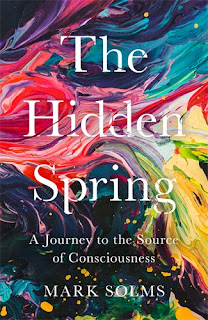South African neuroscientist Mark Solms takes a deep dive into our consciousness with the aim to determine its mechanism, and especially the relationship between the fysiological workings of our body and the elusive and abstract notion of consciousness.
"(...) feelings are always conscious, without exception. That is not to say that all the need-regulating mechanisms in the brain are conscious, but that is my point: it makes a difference whether a need is felt or not. Your water-to-salt ratio may be sliding all the time, in the background, but when you feel it, you want to drink. You might objectively be in danger without noticing it, but when you feel it you look for ways to escape.
Different things call for different names, and the difference between felt and unfelt needs makes it necessary to introduce a terminological distinction. 'Needs' are different from 'affects'. Bodily needs can be registered and regulated autonomically, as in the examples of cardiovascular and respiratory control, thermoregulation and glucose metabolism. These are called 'vegetative' functions, and with a good reason: there is nothing conscious about them. Hence the term autonomic 'reflex'. Consciousness enters the equation only when needs are felt" (p. 99)
Solms then resorts to physics in an attempt to solve the 'hard problem', the actual transition between fysiological and biological phenomena into the level of immaterial consciousness, especially the laws of thermodynamics and the minimisation of free energy, with concepts of order and entropy." (...) human emotions are complex versions of the same type of thing. They, too, are ultimately 'error' signals which register deviations from your biologically preferred states, which tell you whether the steps you are taking are making things better or worse for you.
There is unfortunately no generally agreed upon classification of affects in current neuropsychology. I have drawn a distinction between bodily and emotional affects, but such sharp demarcations do not exist in nature. In drawing this line, I am following Jaak Panksepp's taxonomy, which is widely - but not universally - accepted. He further divided bodily affects, of which there are a great variety, into interoceptive ('homeostatic') and exteroceptive ('sensory') subtypes. Hunger and thirst, for example, are homeostatic affects, whereas pain, surprise and disgust are sensory ones.,,. So, to be clear, according to Panksepp there are three types of affect: homeostatic and sensory ones (both of which are bodily) and emotional ones (which involve the body but cannot be described as 'bodily' in any simple sense). Think, for example, of missing your brother, which is an emotional state; it is not bodily in the same way that hunger and pain are" (p. 102)
"(...)the great mystery of this conjunction - the mystery of how subjective experience fits into the fabric of the physical universe - could be solved only if we reduce physiological and psychological phenomena alike to their underlying mechanistic causes. These causes were to be revealed at a depth of abstraction that only physics could provide."(p.191)
The whole concept can be quantified by linking laws of probability with the use of energy. You become conscious only of things that deserve to get the energy needed for the active participation of the agent.
He also refers to the fact that the real brain area of consciousness is in our most animal part of the brain, which also drives our basic emotions of fear and lust, of fight or flight.
" (...) consciousness ultimately arises not in the cortex, the seat of advanced intelligence, but in the more primitive brainstem, where basic emotions begin. The fundamental form of consciousness is not something cognitive, like vision; rather, it is something affective. In that sense, and that sense alone, Chalmers was right to imply that consciousness is not a cognitive function: the primary function of consciousness is not perceiving or remembering or comprehending but feeling. How can the function of feeling go on 'in the dark', without any feeling? We can legitimately ask why vision is accompanied by experience. Vision does not require consciousness, and neither does any other cognitive process. But feeling does." (p. 265)
I think Solms goes a little too far in his theories on 'artificial sentience', as if human consciousness could be replicated with the right conditions in a machine. The immense complexity of our human biology can still not be replicated by any mechanical context, not by a long stretch.


No comments:
Post a Comment